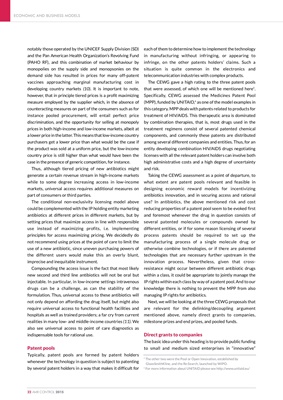
notably those operated by the UNICEF Supply Division (SD)
and the Pan American Health Organization's Revolving Fund
(PAHO RF), and this combination of market behaviour by
monopolies on the supply side and monopsonies on the
demand side has resulted in prices for many off-patent
vaccines approaching marginal manufacturing cost in
developing country markets (10). It is important to note,
however, that in principle tiered prices is a profit maximizing
measure employed by the supplier which, in the absence of
counteracting measures on part of the consumers such as for
instance pooled procurement, will entail perfect price
discrimination, and the opportunity for selling at monopoly
prices in both high-income and low-income markets, albeit at
a lower price in the latter. This means that low-income country
purchasers get a lower price than what would be the case if
the product was sold at a uniform price, but the low-income
country price is still higher than what would have been the
case in the presence of generic competition, for instance.
Thus, although tiered pricing of new antibiotics might
generate a certain revenue stream in high-income markets
while to some degree increasing access in low-income
markets, universal access requires additional measures on
part of consumers or third parties.
The conditional non-exclusivity licensing model above
could be complemented with the IP holding entity marketing
antibiotics at different prices in different markets, but by
setting prices that maximize access in line with responsible
use instead of maximizing profits, i.e. implementing
principles for access maximizing pricing. We decidedly do
not recommend using prices at the point of care to limit the
use of a new antibiotic, since uneven purchasing powers of
the different users would make this an overly blunt,
imprecise and inequitable instrument.
Compounding the access issue is the fact that most likely
new second and third line antibiotics will not be oral but
injectable. In particular, in low-income settings intravenous
drugs can be a challenge, as can the stability of the
formulation. Thus, universal access to these antibiotics will
not only depend on affording the drug itself, but might also
require universal access to functional health facilities and
hospitals as well as trained providers; a far cry from current
realities in many low- and middle-income countries (11). We
also see universal access to point of care diagnostics as
indispensable tools for rational use.
Patent pools
Typically, patent pools are formed by patent holders
whenever the technology in question is subject to patenting
by several patent holders in a way that makes it difficult for
each of them to determine how to implement the technology
in manufacturing without infringing, or appearing to
infringe, on the other patents holders' claims. Such a
situation is quite common in the electronics and
telecommunication industries with complex products.
The CEWG gave a high rating to the three patent pools
that were assessed, of which one will be mentioned here5.
Specifically, CEWG assessed the Medicines Patent Pool
(MPP), funded by UNITAID,6 as one of the model examples in
this category. MPP deals with patents related to products for
treatment of HIV/AIDS. This therapeutic area is dominated
by combination therapies, that is, most drugs used in the
treatment regimens consist of several patented chemical
components, and commonly these patents are distributed
among several different companies and entities. Thus, for an
entity developing combination HIV/AIDS drugs negotiating
licenses with all the relevant patent holders can involve both
high administrative costs and a high degree of uncertainty
and risk.
Taking the CEWG assessment as a point of departure, to
what extent are patent pools relevant and feasible in
designing economic reward models for incentivizing
antibiotics innovation, and in securing access and rational
use? In antibiotics, the above mentioned risk and cost
reducing properties of a patent pool seem to be evoked first
and foremost whenever the drug in question consists of
several patented molecules or compounds owned by
different entities, or if for some reason licensing of several
process patents should be required to set up the
manufacturing process of a single molecule drug or
otherwise combine technologies, or if there are patented
technologies that are necessary further upstream in the
innovation process. Nevertheless, given that crossresistance
might occur between different antibiotic drugs
within a class, it could be appropriate to jointly manage the
IP rights within each class by way of a patent pool. And to our
knowledge there is nothing to prevent the MPP from also
managing IP rights for antibiotics.
Next, we will be looking at the three CEWG proposals that
are relevant for the delinking/decoupling argument
mentioned above, namely direct grants to companies,
milestone prizes and end prizes, and pooled funds.
Direct grants to companies
The basic idea under this heading is to provide public funding
to small and medium sized enterprises in "innovative"
ECONOMIC AND BUSINESS MODELS
22 AMR CONTROL 2015
5 The other two were the Pool or Open Innovation, established by
GlaxoSmithKline, and the Re:Search, launched by WIPO.
6 For more information about UNITAID please see http://www.unitaid.eu/